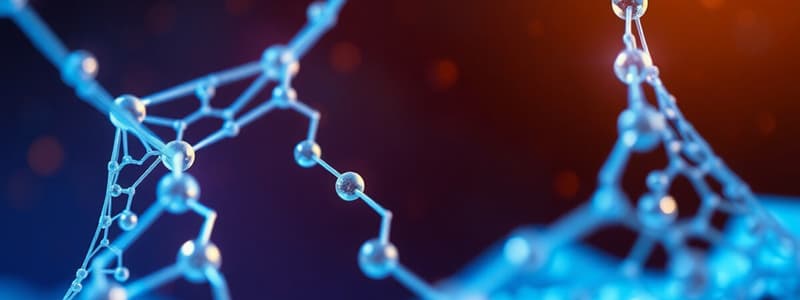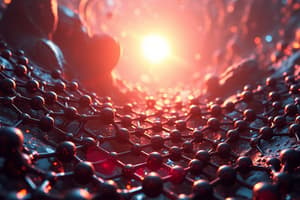Podcast
Questions and Answers
What is one potential benefit of using graphene oxide filters in desalination?
What is one potential benefit of using graphene oxide filters in desalination?
- They can remove dissolved gases from water efficiently.
- They may outperform other desalination techniques significantly. (correct)
- They require less energy to operate than conventional methods.
- They can filter more liquid types than traditional filters.
Which characteristic of graphene films makes them suitable for use in dye-sensitized solar cells?
Which characteristic of graphene films makes them suitable for use in dye-sensitized solar cells?
- Their low cost of production compared to silicon.
- Their ability to be produced in large quantities.
- Their extreme thickness which enhances stability.
- Their high conductivity and transparency. (correct)
In what way could graphene contribute to advancements in supercapacitors?
In what way could graphene contribute to advancements in supercapacitors?
- By enhancing energy storage density with its surface area. (correct)
- By decreasing charge time significantly.
- By functioning as a better insulator.
- By reducing the weight of the supercapacitors.
What application was found to be highly effective for graphene oxide in 2010?
What application was found to be highly effective for graphene oxide in 2010?
Which application is NOT mentioned as a use for graphene?
Which application is NOT mentioned as a use for graphene?
What is a notable property of electrons flowing through graphene?
What is a notable property of electrons flowing through graphene?
How does graphene's thermal conductivity compare to other carbon structures?
How does graphene's thermal conductivity compare to other carbon structures?
Which application is graphene NOT currently used for as of 2014?
Which application is graphene NOT currently used for as of 2014?
Why is graphene advantageous for integrated circuits?
Why is graphene advantageous for integrated circuits?
What percentage of light does graphene absorb that passes through it?
What percentage of light does graphene absorb that passes through it?
In which area is graphene being developed for potential applications?
In which area is graphene being developed for potential applications?
Which characteristic of graphene enhances its suitability for optoelectronic applications?
Which characteristic of graphene enhances its suitability for optoelectronic applications?
How does the ballistic thermal conductance of graphene behave in different directions?
How does the ballistic thermal conductance of graphene behave in different directions?
What is the structural arrangement of carbon atoms in graphene?
What is the structural arrangement of carbon atoms in graphene?
Which of the following statements about the mechanical properties of graphene is true?
Which of the following statements about the mechanical properties of graphene is true?
What notable award did Andre Geim and Konstantin Novoselov receive for their work on graphene?
What notable award did Andre Geim and Konstantin Novoselov receive for their work on graphene?
How does graphene's chemical reactivity compare to other carbon forms?
How does graphene's chemical reactivity compare to other carbon forms?
Which technique was used to calculate the strength of graphene?
Which technique was used to calculate the strength of graphene?
What characteristic distinguishes graphene from other solid materials in terms of its chemical properties?
What characteristic distinguishes graphene from other solid materials in terms of its chemical properties?
What is the highest temperature at which graphene burns?
What is the highest temperature at which graphene burns?
What type of material is graphene classified as in terms of its dimensionality?
What type of material is graphene classified as in terms of its dimensionality?
Flashcards
Graphene's structure
Graphene's structure
Graphene is a 2D material made of carbon atoms arranged in a honeycomb lattice. Each carbon atom is bonded to three others.
Graphene's strength
Graphene's strength
Graphene is incredibly strong, harder than diamond, and much stronger than steel, capable of stretching up to 20% of its original length.
Graphene's dimensionality
Graphene's dimensionality
Graphene is a 2D material, unlike 0D, 1D, and 3D materials. It's a single layer.
Graphene's chemical reactivity
Graphene's chemical reactivity
Signup and view all the flashcards
Graphene's electrical conductivity
Graphene's electrical conductivity
Signup and view all the flashcards
Graphene's Nobel Prize
Graphene's Nobel Prize
Signup and view all the flashcards
Graphene's thickness
Graphene's thickness
Signup and view all the flashcards
Graphene origin
Graphene origin
Signup and view all the flashcards
Graphene for Desalination
Graphene for Desalination
Signup and view all the flashcards
Graphene for Ethanol Distillation
Graphene for Ethanol Distillation
Signup and view all the flashcards
Graphene in Solar Cells
Graphene in Solar Cells
Signup and view all the flashcards
Graphene for Energy Storage
Graphene for Energy Storage
Signup and view all the flashcards
Graphene's Anti-Bacterial Properties
Graphene's Anti-Bacterial Properties
Signup and view all the flashcards
Graphene's Thermal Conductivity
Graphene's Thermal Conductivity
Signup and view all the flashcards
Graphene's Optical Properties
Graphene's Optical Properties
Signup and view all the flashcards
Graphene's High Carrier Mobility
Graphene's High Carrier Mobility
Signup and view all the flashcards
Graphene Applications (electronics)
Graphene Applications (electronics)
Signup and view all the flashcards
Graphene Applications (optical)
Graphene Applications (optical)
Signup and view all the flashcards
Graphene's Potential Biomedical Use
Graphene's Potential Biomedical Use
Signup and view all the flashcards
Graphene's Properties Summary
Graphene's Properties Summary
Signup and view all the flashcards
Study Notes
Introduction
- Graphene is a one-atom thick layer of graphite.
- It's the fundamental building block of other allotropes like graphite, charcoal, carbon nanotubes, and fullerenes.
- Graphene is the strongest and thinnest material known.
- Graphene is an atomic-scale honeycomb lattice composed of carbon atoms.
- Graphene is a 2D crystal of carbon atoms arranged in a honeycomb lattice.
- Each carbon atom is sp² hybridized and bonded to three neighbors.
History
- A patent for graphene production was filed in 2002, titled "Nano-scaled Graphene Plates."
- In 2004, Andre Geim and Kostya Novoselov at the University of Manchester extracted single-atom-thick graphene crystals from bulk graphite.
- Geim and Novoselov received the 2010 Nobel Prize in Physics for their graphene research.
Structure
- Graphene is a 2-dimensional network of carbon atoms bonded together in a honeycomb pattern.
- The carbon atoms are bound tightly within a plane by strong bonds forming six-membered rings.
- Stacking these layers creates the well-known 3D graphite structure.
- Graphene is the basic building block for all other graphitic materials, with different dimensionalities.
- It can be transformed into 0D fullerenes, 1D nanotubes, or stacked into 3D graphite.
Mechanical Properties
- Scientists use Atomic Force Microscopy to calculate graphene's strength.
- Graphene is harder than diamond, and 300 times harder than steel.
- Graphene's tensile strength surpasses 1 TPa (teraPascal).
- It can be stretched up to 20% of its original length.
Chemical Properties
- Graphene is the most reactive form of carbon.
- Each carbon atom is exposed on two sides due to graphene's 2D structure, increasing its reactivity.
- Edge carbon atoms in graphene sheets are chemically reactive.
- Graphene burns at a low temperature (e.g., 350°C).
- It has a high ratio of edge carbon atoms compared to other carbon materials like carbon nanotubes.
- Graphene can be modified with oxygen and nitrogen containing functional groups.
Electronic Properties
- Graphene is a zero-overlap semimetal with high electrical conductivity.
- Electrons pass through graphene extremely fast, nearly 1/100th the speed of light.
- Graphene exhibits high charge carrier mobility, with reported values reaching 200,000 cm²/Vs.
Thermal Properties
- Graphene is a perfect thermal conductor.
- Its thermal conductivity is significantly higher than other carbon forms like carbon nanotubes, graphite, and diamond.
- The thermal conductivity of graphene is 5,000 W/m⋅K at room temperature.
- Graphite (3D form of graphene) has a lower thermal conductivity of approximately 1000 W/m⋅K.
- The thermal conductance of graphene is isotropic (same in all directions).
Optical Properties
- Graphene, despite its one-atom thickness, is visible to the naked eye.
- Graphene absorbs a significant amount (2.3%) of light passing through it due to its electronic properties.
Applications
- Graphene's mechanical and optical properties make it suitable for producing lightweight, strong composite materials.
- Potential for flexible displays.
- Proposed for DNA sequencing (analysis).
- Use in high-speed transistors for processors.
- Potential for transparent conducting electrodes in optoelectronic devices (touchscreens, liquid crystal displays, organic photovoltaics, and organic light-emitting diodes.).
- Possible use in graphene-based filters for desalination & alcohol production.
- Potential for use in solar cells, improving photoelectrochemical energy conversion.
- Possible application in energy storage devices (supercapacitors).
- Potential antimicrobial applications for hygiene products and packaging.
- Wide range of other potential applications including composite materials, infrared detectors, single-molecule gas detection, piezoelectric materials, energy harvesting, liquid cells for electron microscopy, thermal management materials, optical modulators, and chemical sensors.
Biomedical
- Graphene could be used to analyze DNA at an exceptionally fast pace.
- The method involves sending DNA through a tiny slit in a graphene sheet.
Integrated Circuits
- Graphene's high carrier mobility and low noise make it a viable candidate as a channel for field-effect transistors.
- 100 GHz transistors can be developed on 2-inch graphene sheets.
- Graphene-based integrated circuits handle frequencies up to 10 GHz.
- Transistors printed on flexible plastic using graphene operate at 25 gigahertz.
- Graphene enables terahertz-speed transistors.
Other Applications
- Graphene nanoribbons
- Infrared detectors
- Single-molecule gas detection
- Piezoelectric materials
- Energy Harvesting
- Composite Materials
- Liquid Cells for Electron Microscopy
- Thermal management materials
- Optical Modulators
- Chemical sensors
Studying That Suits You
Use AI to generate personalized quizzes and flashcards to suit your learning preferences.




